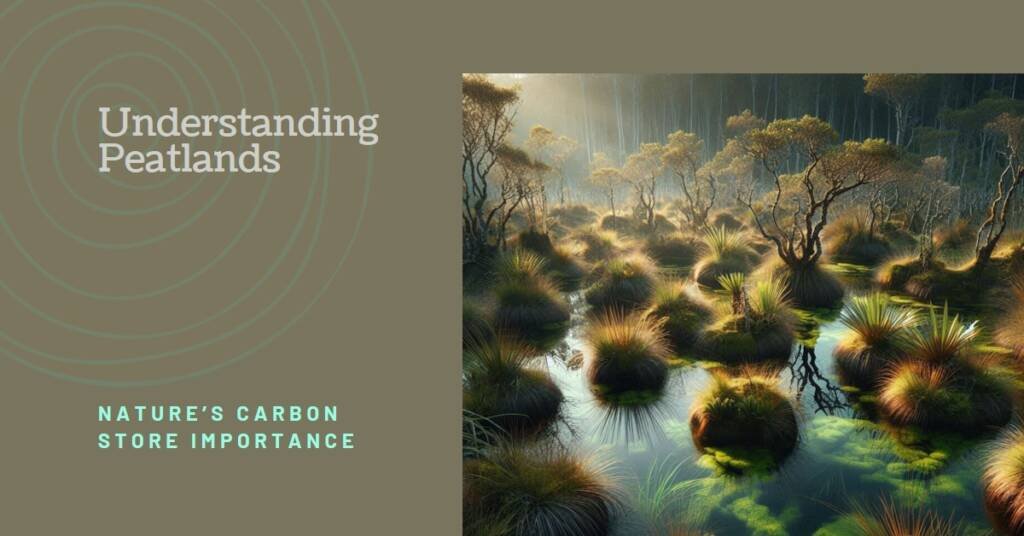
Table of Contents
- Introduction to Peatlands
- The Role of Peatlands in Carbon Storage
- Biodiversity in Peatlands
- Peatland Degradation and Its Consequences
- Peatlands and Climate Change Mitigation
- Cultural and Economic Importance of Peatlands
- Conservation Efforts for Peatlands
- Future Challenges and Opportunities for Peatlands
- Conclusion: The Importance of Understanding Peatlands
Introduction to Peatlands
Peatlands, distinct and vital ecosystems, are characterized by the accumulation of peat, a layer of partially decayed organic matter, primarily derived from sphagnum mosses. These wetlands form in waterlogged conditions where decomposition is slower than the rate of plant material accumulation, resulting in a unique carbon-rich environment. Understanding peatlands requires an exploration into their formation, composition, and ecological significance.
The formation of peatlands typically occurs in areas with poor drainage where excessive moisture prevents the complete decomposition of plant material. This environment is often acidic and low in nutrients, contributing to the slow rate of decomposition. Over millennia, repeated cycles of plant growth and decay lead to a thick layer of peat, which can store vast amounts of carbon dioxide. It is noteworthy that a mere 3% of the Earth’s land surface consists of peatlands, yet they harbor approximately 30% of the world’s soil carbon.
In addition to carbon storage, peatlands support distinctive biodiversity. They provide unique habitats for various species of flora and fauna, many of which are specially adapted to thrive in wet, acidic conditions. The vegetation found in peatlands often includes species like sedges, grasses, and unique mosses, which play an integral role in the ecosystem’s overall health and resilience. These natural systems also serve crucial hydrological functions, influencing water quality and availability in surrounding areas. Their complex interactions with the climate further underline the significance of understanding peatlands, particularly regarding their contributions to carbon sequestration and global climate regulation.
By exploring these ecosystems, researchers and environmentalists can work towards effective conservation strategies, ensuring the protection of peatlands and their invaluable contributions to ecological balance and climate stability.
The Role of Peatlands in Carbon Storage
Peatlands, often characterized by their waterlogged conditions and an accumulation of organic matter, play an essential role in carbon storage, acting as significant carbon sinks. These unique ecosystems cover about three percent of the Earth’s land surface but store approximately one-third of the world’s soil carbon, making them crucial in the context of understanding peatlands and their environmental impact. The carbon stored in peatlands remains locked away in the form of partially decomposed plant material, which accumulates over thousands of years due to the anaerobic conditions that inhibit microbial decomposition.
Through a process known as carbon sequestration, peatlands absorb carbon dioxide (CO₂) from the atmosphere during photosynthesis. The waterlogged conditions slow down the decomposition of organic matter in peat, allowing carbon to build up significantly compared to other ecosystems such as forests or grasslands. As a result, peatlands store more carbon per unit area than tropical forests, which has profound implications for climate change mitigation efforts. It is estimated that intact peatlands hold around 550 gigatons of carbon, roughly equivalent to the total annual emissions of human activities over the last decade.
However, the degradation of peatlands poses a significant threat to their ability to sequester carbon. When drained for agriculture or development, these ecosystems release stored carbon back into the atmosphere, exacerbating climate change. Consequently, understanding peatlands is not just about recognizing their role in storing carbon but also about prioritizing their conservation and restoration. Protecting these unique landscapes is crucial in efforts to achieve global climate goals and maintain biodiversity, making it essential for policymakers, researchers, and land managers alike to engage with strategies that preserve peatland ecosystems effectively.
Biodiversity in Peatlands
Peatlands are among the most important ecosystems on Earth, not only for their role in carbon storage but also for their rich biodiversity. These wetlands provide a unique habitat for a variety of plant and animal species, many of which have adapted specifically to the saturated conditions and acidic environments typical of peatland ecosystems. The biodiversity found within these areas is crucial for their ecological balance and health.
The flora of peatlands is characterized by a dominance of mosses, particularly Sphagnum, which plays a vital role in peat formation. These mosses not only contribute to the acidic nature of the environment but also facilitate the accumulation of organic material, creating a layer of peat. Other plant species, such as sedges and various shrubs, have developed specialized adaptations that enable them to thrive in waterlogged conditions. For instance, many of these plants possess shallow root systems that can efficiently uptake nutrients while minimizing the risk of waterlogging damage.
The animal life in peatlands is equally diverse, with numerous species of birds, insects, amphibians, and mammals. Certain bird species, including the elusive black grouse and the cheerful golden plover, rely on peatland habitats for breeding and feeding. Insects thriving in these environments, such as dragonflies and various beetles, play a significant role in pollination and serve as food for higher trophic levels. Amphibians, like frogs and newts, frequently inhabit these wetlands due to their moist environment, which is ideal for reproduction.
Understanding peatlands and the biodiversity within them is essential for promoting effective conservation practices. Healthy peatland ecosystems contribute to resilience against climate change, provide habitat for unique species, and maintain water quality in surrounding areas. Thus, preserving the intricate web of life in peatlands is crucial not only for the species that inhabit them but also for the overall ecological integrity of our planet.
Peatland Degradation and Its Consequences
Peatlands, often referred to as wetlands, are vital ecosystems that play a crucial role in carbon sequestration and biodiversity support. However, they are increasingly facing several threats that lead to significant degradation. Understanding peatlands involves recognizing the environmental pressures they endure from human activities such as draining, development, and climate change.
Draining peatlands for agricultural expansion or urban development dramatically alters their hydrological balance. This alteration results in the release of carbon dioxide and methane, potent greenhouse gases that greatly contribute to climate change. When peatlands are drained, the peat layers dry out, leading to oxidation and decomposition of the organic matter contained within them. It is estimated that degraded peatlands contribute roughly 5% of global anthropogenic carbon emissions annually, highlighting the immense environmental obstacles posed by this degradation.
Moreover, the development of infrastructure, such as roads or buildings, encroaches upon peatland areas, fragmenting habitats and disrupting ecosystems. This not only exacerbates carbon emissions but also leads to a loss of biodiversity. Peatlands harbor a variety of unique flora and fauna, some of which are endemic to these ecosystems. As degradation occurs, many species are unable to survive the altered conditions, leading to diminished wildlife populations and disrupted ecological balances.
Climate change also poses an insidious threat to understanding peatlands as it alters the climate patterns essential for their functioning. Increased temperatures and changing precipitation patterns can further exacerbate peatland drying and degradation. The combined impact of these threats results in a downward spiral that not only affects the peatlands themselves but also contributes to global climate issues and biodiversity crises.
Peatlands and Climate Change Mitigation
Peatlands represent one of the most vital ecosystems in the fight against climate change. Covering only 3% of the Earth’s land surface while storing more than 30% of the world’s soil carbon, understanding peatlands is essential in formulating effective climate change mitigation strategies. The carbon sequestered within peatlands remains largely undisturbed when these ecosystems are intact; however, disturbances such as drainage, agriculture, and urbanization can release carbon dioxide into the atmosphere, exacerbating climate change. Therefore, maintaining the integrity of these ecosystems is crucial to reducing greenhouse gas emissions.
Restoring degraded peatlands presents a significant opportunity for advancing global climate objectives, particularly in meeting the Paris Agreement goals. By rehabilitating these ecosystems, countries can enhance their carbon sinks and contribute to international efforts aimed at limiting global warming. Conservation practices such as rewetting and controlled flooding not only revive the natural carbon storage capabilities of peatlands but also promote biodiversity and improve water quality in the surrounding areas. Investment in peatland restoration should be viewed as a climate solution, potentially resulting in considerable carbon savings while providing co-benefits for local communities.
Integrating peatland conservation into broader environmental policies is paramount for maximizing their potential in climate change mitigation. Policymakers must recognize the importance of these ecosystems in their national strategies and collaborations. This includes creating frameworks that prioritize peatland preservation, encourage sustainable land-use practices, and involve local stakeholders in decision-making processes. As nations continue to grapple with the pressing challenges of climate change, ensuring the health of peatlands will be a key factor in achieving long-term sustainability and resilience in the face of environmental shifts.
Cultural and Economic Importance of Peatlands
Peatlands, often referred to as “nature’s carbon store,” hold considerable cultural and economic significance for numerous indigenous communities and local populations around the globe. These unique ecosystems are not only vital environmental resources but also serve as repositories of cultural identity and history. Many indigenous groups have lived in proximity to peatlands for generations, relying on their resources for subsistence, cultural practices, and spiritual enrichment. The deep connection that these communities have with their environment emphasizes the importance of understanding peatlands beyond their ecological roles. Traditional practices, such as gathering plants and hunting, are often intertwined with the health and preservation of peatland ecosystems, highlighting their cultural relevance.
In addition to their cultural significance, peatlands provide various economic benefits that can be sustainably developed. The tourism and recreation sectors have increasingly recognized peatlands as areas of natural beauty and biodiversity, attracting visitors for activities such as birdwatching, hiking, and photography. This influx of tourism not only contributes to the local economy but also raises awareness about the importance of conserving these fragile ecosystems. Local communities often engage in the sustainable management of peatland resources, balancing economic interests with their cultural practices and the ecological integrity of the environment.
However, the challenge remains in finding the right balance between conservation efforts and economic development. Unsustainable practices such as peat extraction and agricultural expansion can lead to habitat degradation and carbon release, counteracting the essential role that peatlands play in climate regulation. Therefore, fostering a dialogue between stakeholders—including communities, policymakers, and conservationists—is essential for achieving a synergistic approach that upholds both cultural values and economic interests, ultimately enhancing the understanding of peatlands as multifaceted ecosystems. The need for sustainable resource use in peatlands underscores the growing recognition of their cultural and economic importance in our interconnected world.
Conservation Efforts for Peatlands
Peatlands cover approximately 3% of the Earth’s surface yet play a crucial role in global carbon storage and biodiversity. As the implications of climate change become more pressing, numerous national and international conservation efforts have been initiated to protect and restore these vital ecosystems. One of the most significant international frameworks aimed at addressing peatland conservation is the Ramsar Convention on Wetlands, which emphasizes the need to preserve the ecological character of wetlands, including peatlands. This convention facilitates a framework for cooperation among member countries to manage peatland areas sustainably.
Another noteworthy initiative is the United Nations Framework Convention on Climate Change (UNFCCC). Adopted by many countries, it encourages the involvement of nations to commit to reducing greenhouse gas emissions. The vital role of peatlands in carbon sequestration is highlighted during the Conferences of the Parties (COP), where measures to protect and restore these ecosystems are discussed. Specific projects, such as the Global Peatlands Initiative, focus on sharing knowledge, resources, and best practices among different stakeholders to tackle peatland degradation effectively.
On a local scale, various grassroots initiatives are being implemented to enhance peatland conservation efforts. These projects often involve local communities in the management of peatland areas, recognizing that indigenous and traditional knowledge plays a vital role in preserving these ecosystems. Engaging communities not only fosters a sense of ownership and responsibility but also ensures that conservation strategies are culturally appropriate and effective. Programs that promote sustainable land management practices, such as rewetting drained peatlands and restoring natural hydrology, are increasingly being recognized for their importance in peatland restoration.
In conclusion, a multifaceted approach combining international agreements, local initiatives, and community involvement is essential for successful conservation efforts aimed at understanding peatlands and safeguarding their ecological functions. By fostering collaboration among governments, organizations, and local communities, the potential for effective peatland protection and restoration can be optimized on a global scale.
Future Challenges and Opportunities for Peatlands
Understanding peatlands is crucial to grasping their vital role in our ecosystem, especially as they face a myriad of challenges in the coming years. One of the primary threats to peatlands is climate change, which exerts pressure on their hydrology, biodiversity, and overall functionality. Increased temperatures can lead to the drying out of peatlands, resulting in the release of stored carbon into the atmosphere, exacerbating global warming. Furthermore, changing precipitation patterns can disrupt the delicate balance of water levels in these ecosystems, leading to further degradation.
Human activities, such as agriculture, urbanization, and mining, also pose significant risks to peatlands. Land conversion for agriculture is particularly concerning, as it often involves draining peatlands, thereby releasing carbon emissions and reducing their capacity to sequester further carbon. Urban expansion encroaches on peatland areas, while extractive industries can irreparably damage these valuable ecosystems, leading to loss of biodiversity and ecological functions.
Despite these substantial challenges, there are emerging opportunities for innovative conservation strategies aimed at protecting and restoring peatlands. Technological advancements offer new methods for monitoring peatland health through remote sensing and data analytics. These tools allow for a comprehensive understanding of peatland dynamics, enabling conservationists to implement targeted restoration efforts. Furthermore, integrating indigenous knowledge and community engagement can lead to more effective management practices that respect both ecological and cultural values.
In conclusion, while understanding peatlands reveals the myriad challenges these ecosystems face due to climate change and human activities, it also underscores the potential pathways for conservation through technology and community involvement. Addressing these issues will be critical to preserving peatlands as essential carbon stores and maintaining their ecological integrity for future generations.


Conclusion: The Importance of Understanding Peatlands
Understanding peatlands is essential for recognizing their role as crucial ecosystems that significantly contribute to the Earth’s climate regulation and biodiversity. These areas, often viewed as mere swamps or bogs, harbor a wealth of carbon stored in their organic matter, acting as substantial carbon sinks. By absorbing and storing carbon dioxide from the atmosphere, peatlands help mitigate climate change, highlighting their importance in environmental management and conservation efforts.
Beyond their carbon storage capabilities, peatlands support an intricate web of life. They serve as habitats for a variety of species, many of which are endemic and rely solely on these unique environments. The delicate balance maintained within peatlands fosters biodiversity, making them vital for the ecological health of our planet. Understanding peatlands also involves recognizing the multitude of services they provide, such as water purification and flood regulation, further emphasizing their integral role within our ecosystems.
Given the increasing threats posed by climate change, land-use changes, and conservation challenges, it is imperative that we continue fostering awareness about the need to protect peatlands. Recent deforestation and peatland drainage practices have led to the erosion of these critical habitats, resulting in the release of stored carbon, which exacerbates climate change. Therefore, educating communities about the significance of maintaining these ecosystems is essential for sustainable development and environmental conservation.
In conclusion, safeguarding peatlands is not only vital for combating climate change and preserving biodiversity but also crucial for the well-being of future generations. By prioritizing the understanding of peatlands and advocating for their protection, we can ensure that they remain an essential component of our planet’s ecological landscape.



